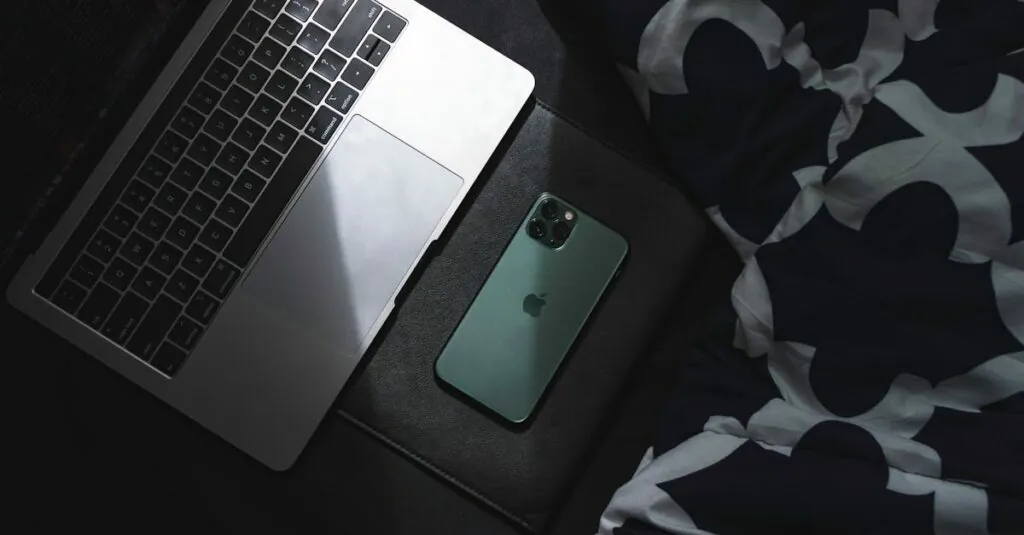Table of Contents
ToggleEver found yourself squinting at your iPhone’s screen under the blazing sun, wishing it could shine brighter than a supernova? You’re not alone. Many iPhone users have faced the struggle of battling glare while trying to catch up on their favorite shows or scroll through social media. But what if there’s a way to crank up that brightness beyond the max setting?
Understanding iPhone Screen Brightness
iPhone screen brightness operates under specific parameters. Users can adjust brightness settings through the Control Center or the Settings app. Typical maximum brightness peaks at around 625 nits for recent iPhone models. Enhanced visibility during sunny conditions often calls for brighter screens to combat glare.
Adaptive Brightness automatically adjusts settings based on ambient light. This feature increases screen brightness in well-lit environments and decreases it in darker spaces. iPhone users can disable this setting to maintain a consistent brightness level, providing greater control.
Manual adjustments offer an alternative. Users can increase brightness through settings while utilizing widgets or shortcuts for quick access. Additionally, certain accessibility features, like Color Filters, can impact perceived brightness.
Third-party apps may provide alternative viewing experiences, allowing users to manipulate screen settings beyond standard limits. While experimenting with these apps, users should be cautious of potential drawbacks. Maintaining battery life becomes essential, as higher brightness settings consume additional power.
Understanding iPhone screen brightness helps users find the right balance between visibility and battery usage. Mastering these settings enhances the overall experience in bright environments, ensuring clarity and comfort while using the device.
The Default Brightness Settings
Understanding the default brightness settings on an iPhone is essential for enhancing visibility in bright environments. Users can adjust various options to maximize screen brightness, going beyond standard limits when necessary.
Adjusting Brightness in Settings
To increase brightness through settings, users should go to the Display & Brightness menu in the Settings app. The slider controls maximum brightness, which can be adjusted upward. Automatic adjustments can be toggled off to maintain a consistent brightness level. Recent iPhone models feature a maximum brightness of around 625 nits. Users seeking higher levels might explore advanced options, such as enabling “True Tone” to improve color accuracy in different lighting conditions. Adjusting settings manually often provides better results in sunlight, ensuring visibility even during glare.
Using Control Center for Quick Adjustments
Control Center offers quick access for brightness adjustments, simplifying the process without navigating through menus. To access Control Center, users can swipe down from the top right corner of the screen. The brightness slider allows immediate fine-tuning with ease. Users can increase screen brightness rapidly by dragging the slider upward. This feature supports quick adaptations to changing environments, making it an efficient tool for those in bright areas. Frequent adjustments can optimize visibility and enhance user experience under direct sunlight conditions.
Techniques to Increase Screen Brightness Beyond Maximum
Increasing screen brightness beyond the maximum setting enhances visibility in bright environments. Users can employ various techniques to achieve this goal.
Enabling Auto-Brightness
Auto-Brightness adjusts the screen’s brightness according to surrounding light conditions. This feature senses ambient light and modifies brightness dynamically. To enable Auto-Brightness, navigate to Settings, select Accessibility, then tap Display & Text Size, and finally toggle on Auto-Brightness. Users benefit from a consistent display experience regardless of lighting conditions. Keeping Auto-Brightness activated might help when moving between different environments.
Using Accessibility Settings
Accessibility settings offer options that can enhance perceived brightness on the iPhone. Color Filters can alter color schemes, making screens appear brighter. To access this, head to Settings, select Accessibility, then tap Display & Text Size. From there, enabling Color Filters can help create a more vivid screen experience. Users can choose from various filters, such as Grayscale or Inverted colors, each affecting brightness perception differently. These adjustments can significantly improve visibility in challenging lighting.
Third-Party Apps for Enhanced Brightness
Third-party apps provide additional control over screen brightness settings. Apps designed to modify display parameters can push brightness limits beyond standard configurations. Users seeking enhanced visibility may explore options available in the App Store. It’s vital to read reviews before downloading, as battery impact can vary across applications. Some popular apps allow tinted overlays, enabling brighter displays in high-glare situations. Proper management of these settings helps ensure an optimal viewing experience in bright sunlight.
Managing Battery Life While Increasing Brightness
Balancing increased screen brightness and battery life requires careful management. Users often notice a significant impact on battery performance when brightness settings rise above the typical maximum.
Understanding Battery Impact
Increased screen brightness can drastically reduce battery efficiency. Brightness at levels beyond the default maximum strains the battery, leading to faster depletion. Recent iPhones feature standard maximum brightness around 625 nits. Raising brightness further, particularly in bright environments, results in additional energy consumption. Users should recognize that prolonged use of higher brightness settings can lead to shorter battery life. Monitoring how brightness adjustments correlate with battery usage is vital for maintaining device longevity.
Tips for Optimizing Battery Usage
To conserve battery while maximizing screen brightness, users can adopt several strategies. Lowering background activity prolongs battery life without sacrificing brightness. Reducing unnecessary notifications helps minimize power drain. Switching off location services when not in use aids battery conservation. Utilizing dark mode can also reduce energy consumption. Users should adjust screen brightness based on ambient light levels whenever possible. Finally, exploring power-saving modes optimizes performance while allows for increased brightness when needed.
Maximizing iPhone screen brightness beyond the standard limits can significantly enhance visibility in bright environments. By utilizing features like manual brightness adjustments and disabling Adaptive Brightness, users can enjoy a clearer display. Exploring accessibility settings and third-party apps offers additional options for those needing extra brightness.
While increasing brightness can improve the viewing experience, it’s essential to manage battery life effectively. Users should monitor their battery performance as they make adjustments to ensure they maintain a balance between brightness and longevity. With the right techniques and settings, iPhone users can conquer glare and enjoy their devices even in the sunniest conditions.







